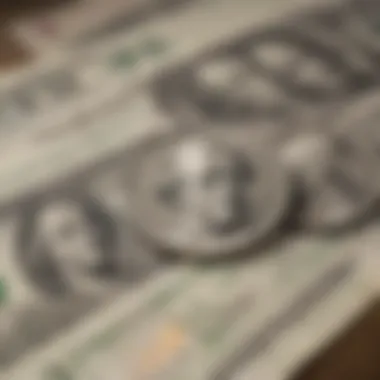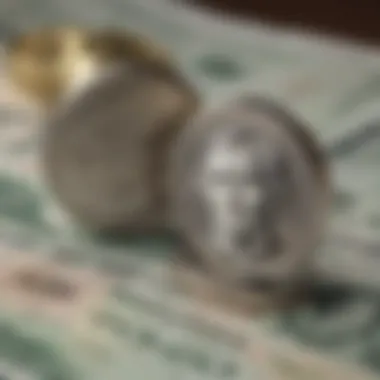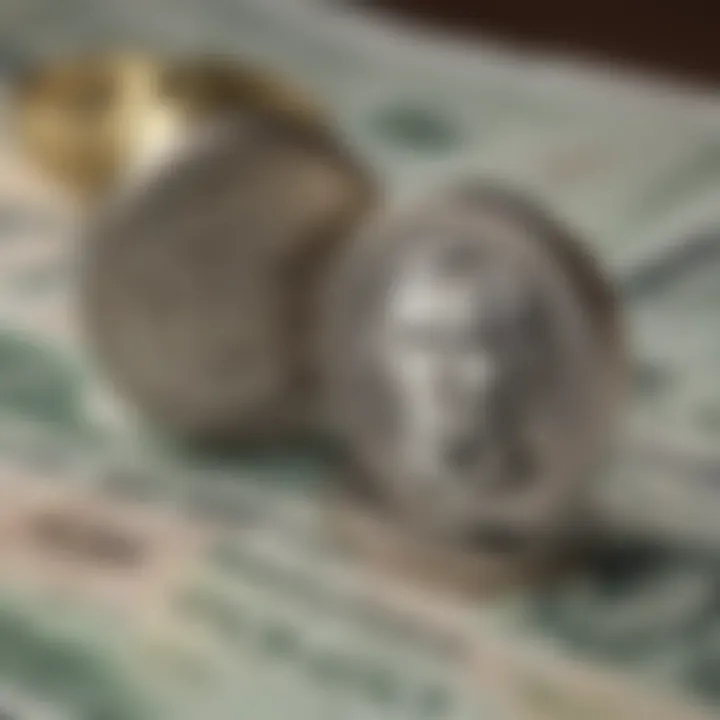Exploring US Dollar to Philippine Peso Exchange Dynamics


Intro
Understanding the mechanisms that drive the exchange rates between the US dollar and the Philippine peso is essential for investors and businesses alike. The nuances of currency conversion can greatly influence individual decisions, whether one is transferring money for personal use or executing large-scale transactions as part of international trade. The interplay between economic indicators, historical patterns, and market sentiment creates a tapestry that is often complex and unpredictable.
This article invites you to explore the essential dynamics underpinning the US dollar to Philippine peso exchange rates. You will learn about vital economic factors, such as inflation rates, interest rates, and geopolitical events, which play critical roles in currency valuation. Furthermore, we will look at how to interpret historical trends and apply this understanding to make savvy decisions in today’s fast-paced financial markets.
In our journey through the exchange dynamics, we aim to equip you with a well-rounded grasp of the topic—whether you are an enthusiastic newcomer in the investment landscape or a seasoned market veteran. This exploration will uncover the strategies to navigate currency conversion effectively, enhancing your capacity to make informed financial choices.
Let’s dive deeper into the lexicon of this field, ensuring you’re well-versed in the key terms and their practical applications.
Preamble to Currency Conversion
Understanding how currency conversion works goes beyond the simple act of swapping money at a foreign exchange booth. In the context of exchanging US dollars for Philippine pesos, there are a myriad of factors at play that could affect not just the conversion rate but also the economic health of both nations involved. Grasping the essentials of currency conversion is crucial for anyone looking to engage in international finance, trade, or even travel. It enables investors, financial advisors, and analysts to make informed decisions based on real-time data and historical context.
One can think of currency conversion as the heartbeat of global trade; it’s where commerce meets finance. Those engaging in this arena must consider several elements, such as market trends, geopolitical implications, and economic indicators. Ignoring these factors could mean leaving money on the table or, worse, incurring losses.
In laying the groundwork for our exploration of the US dollar to Philippine peso dynamics, we will cover important aspects such as how exchange rates are determined, what influences these rates, and why they're significant to businesses and individuals alike. This background knowledge will provide the necessary framework for more advanced discussions in later sections.
Understanding Exchange Rates
At its core, an exchange rate is the price of one currency in terms of another. In this case, it refers to how many Philippine pesos can be exchanged for a single US dollar. Exchange rates can fluctuate due to various factors, including demand and supply dynamics, interest rates, and economic stability. For instance, if the US economy is perceived to be doing well, demand for the dollar may rise, thereby increasing its value against the peso.
Understanding these rates isn't just academic; it can be a game changer for investors. When the exchange rate is favorable, converting dollars to pesos can yield significant returns. Conversely, a sudden drop in value can lead to losses, making it imperative to keep a pulse on the market.
The Importance of Currency Markets
Currency markets, often referred to as Forex, are the arenas where all these transactions take place. The foreign exchange market is one of the largest and most liquid financial markets in the world. It operates 24/5, allowing traders to buy and sell currency pairs at any given moment.
Being aware of the intricacies of currency markets can directly benefit investors. Here’s how:
- Access to Information: Currency traders have near-instant access to news and data that may influence exchange rates.
- Liquidity: High trading volumes mean that it’s easier to enter and exit trades without significant price fluctuations.
- Hedging Opportunities: Businesses can mitigate risks associated with currency fluctuations through various financial instruments.
In the Forex market, knowledge is your best tool. Without a solid understanding of how currency dynamics work, you’re just wading through troubled waters.
In summary, the importance of understanding currency conversion and the factors affecting it cannot be overstated. This knowledge lays the foundation for intelligent investment and financial decisions. Moving forward, we will delve deeper into the historical context of the US dollar and the Philippine peso to provide a more comprehensive understanding of the current exchange dynamics.
Historical Context of US Dollar and Philippine Peso
Understanding the historical context of the US dollar to Philippine peso exchange rate is crucial for anyone venturing into currency exchange. This journey through time not only reveals how the exchange rate has shifted but also offers an insight into the economic, political, and social factors that’ve shaped this relationship. When assessing foreign exchange, recognizing the backdrop against which these fluctuations occur provides investors with a more holistic view of the currency landscape, helping to make informed decisions.
Evolution of the Exchange Rate
The exchange rate between the US dollar and the Philippine peso has been influenced by various events and policies over the decades. To illustrate this, let’s take a little trip down memory lane.
The significance of the Philippine peso can be traced back to the country’s colonial history, with the peso being established during the Spanish regime in the 19th century. After the Philippine-American War, the peso was pegged to the US dollar at a fixed rate, which remained relatively stable until World War II disrupted economic conditions.
As the decades rolled on, the floating exchange rate system introduced in the 1970s altered this firm grip. Since then, the rate has become susceptible to market forces, creating fluctuations based on supply and demand dynamics. In the late 1980s and early 1990s, the peso experienced a significant devaluation, largely triggered by political instability and economic turmoil, leading to a crisis that rippled through the markets.
Fast forward to the 21st century, and the peso has faced new challenges, including external economic pressures, fluctuations in oil prices, and systemic issues within the Philippines’ economic framework. For example, when the global financial crisis hit in 2008, currencies across the world were rocked, and the peso was no different, showing its fragility amidst global uncertainty.
Ultimately, looking at the evolution of this exchange rate offers a vital lens, enabling investors to perceive the inherent risks and opportunities in the currency market today.
Key Economic Events Impacting the Peso
Several key economic events have had lasting impacts on the Philippine peso, shaping its current value against the dollar. These events are not just isolated incidents; they represent broader economic trends that demonstrate how interconnected global economies can be.
- The Asian Financial Crisis (1997): This was a watershed moment for the Philippine economy. In the wake of the crisis, the peso underwent a dramatic depreciation against the dollar, resulting in soaring inflation and a plunge in investor confidence.
- The Global Financial Crisis (2008-2009): Again, the peso was at the mercy of global tides. The crisis led to decreased remittances from overseas Filipino workers, which are vital to the economy, and caused a wave of uncertainty in the markets.
- COVID-19 Pandemic (2020): The pandemic shook the world, and the peso reflected that. Travel bans and lockdowns delivered a heavy blow to an economy heavily reliant on tourism. As businesses faltered and job losses spiked, the peso was thrust into volatility, highlighting its vulnerable position in a global crisis.
These events are illustrative of the complex relationship between the US dollar and the Philippine peso, driven by local and international factors alike. They reaffirm the notion that a seemingly simple exchange rate is a window to understanding broader economic dynamics at play.
Overall, the historical context provides not just a backdrop but also valuable lessons in resilience and adaptation that can inform future investment strategies.


Current Exchange Rate Dynamics
Understanding the current exchange rate dynamics between the US dollar and the Philippine peso is paramount for a myriad of stakeholders, from investors to financial analysts. These dynamics reflect not only the immediate monetary relationship between the two currencies but also encapsulate broader economic narratives. Grasping the elements at play in this domain can facilitate informed decisions, helping individuals and businesses to navigate the ever-shifting tides of currency valuation.
Exchange rates are not static; they fluctuate due to various factors. Recognizing the intricate connections between these elements is crucial for making strategic financial decisions. The daily grind of the forex market is influenced by several variables like economic indicators, interest rates, and political landscapes. As a result, understanding these dynamics equips participants in the currency market with the tools to respond to changes swiftly and effectively.
Factors Affecting the Rate
Numerous factors influence the exchange rate between the US dollar and the Philippine peso. Here are some key components to consider:
- Economic Indicators: Metrics such as GDP growth, unemployment rates, and consumer spending play significant roles in shaping currency values. A robust economic performance typically strengthens the currency.
- Interest Rates: The relationship between US and Philippine interest rates greatly impacts bilateral exchange rates. Higher interest rates in the US can attract more foreign investment, boosting the dollar's strength against the peso.
- Political Stability: Political upheaval or instability can lead to uncertainty among investors, often resulting in a depreciation of the local currency. Investors generally favor stable environments.
- Inflation Rates: Inflation affects purchasing power. If inflation is higher in the Philippines compared to the US, it can decrease the value of the peso relative to the dollar.
With all these variables mingling, navigating currency exchange can feel like walking a tightrope. Each factor intertwines, creating a complex tapestry that defines how both currencies interact.
Market Sentiment and Speculation
Market sentiment often drives the decisions of traders, in addition to the actual economic indicators. Speculators, looking to capitalize on what they perceive to be shifts in currency value, can cause fluctuations, some of which are not entirely aligned with the underlying economic fundamentals.
- Investor Sentiment: A positive outlook towards the US economy can lead to increased demand for the dollar. For instance, if investors believe the Federal Reserve is likely to raise interest rates, the dollar might see a surge in value as investors pour funds into US assets.
- News and Trends: Social media and news outlets can prompt quick reactions. Bad news for the economy can lead to a sell-off in relations to the peso while good news can instantly lift its value. The age of rapid information exchange means that perceptions can change overnight.
- Behavioral Economics: Traders often act irrationally. Speculative bubbles can create discrepancies between actual value and market price.
In sum, while the mechanics of the currency market may seem straightforward, the influences of sentiment and speculation add an unpredictable layer. It's a dance of market psychology, where perceptions sometimes overshadow reality, leading to dramatic swings in exchange rates.
Economic Indicators and Their Influence
Understanding economic indicators is pivotal when analyzing the exchange dynamics between the US Dollar and the Philippine Peso. These indicators serve as the pulse of an economy, providing essential insights into financial health, trends, and future movements. Investors, financial advisors, and analysts need to monitor these data points closely, as they impact both short-term currency fluctuation and long-term trends in exchange rates.
Interest Rates and Inflation
The interplay between interest rates and inflation is a critical aspect for anyone concerned with currency exchange. In the United States, when the Federal Reserve raises interest rates, it often results in a stronger dollar. Higher interest yields attract foreign capital, increasing demand for the currency. Conversely, in the Philippines, if interest rates are hiked, it can provide the peso with similar support, fostering a balanced nurturing of local economic confidence.
However, inflation tells a different story. If inflation outpaces growth, it can erode purchasing power, lessening the value of a currency. For instance, if the US experiences high inflation while keeping interest rates low, the dollar could weaken, creating ripples felt far beyond its borders.
Consider these points:
- Higher Interest Rates Strengthen Currency: This principle holds true as capital flows toward regions with better returns.
- Inflation Weakens Purchasing Power: A currency can lose its charm in international markets if domestic prices skyrocket.
"A country’s inflation rate is often seen as a reflection of its economic health; higher rates can raise red flags for foreign investors."
Investors often turn to see which way the economic winds are blowing regarding these indicators. Tapping into these insights can make all the difference when planning exchanges and investments.
GDP Growth and Economic Stability
Gross Domestic Product (GDP) and its growth rate are prime indicators of an economy's overall health. If the Philippine GDP is growing steadily, the optimism that creates can lead to a stronger peso. Conversely, a sluggish GDP growth can make both investors and consumers wary, leading to decreased demand for the peso against the dollar.
Economic stability is not just about numbers; it’s about confidence. If investors see a country as stable, they’re more likely to invest, which in turn supports the currency. Factors like political stability, regulatory environment, and economic diversification contribute significantly.
Highlighting key aspects:
- Positive GDP Growth Signals: Higher growth can attract FDI (Foreign Direct Investment), enhancing currency value.
- Economic Stability Promotes Currency Strength: A secure environment encourages capital inflow, bolstering the peso.
Geopolitical Factors at Play
The world of currency exchange doesn’t just hinge on economic indicators or market trends; it dances along the delicate thread of geopolitics. When considering the exchange dynamics of the US dollar to the Philippine peso, understanding these factors is crucial. Geopolitical events shape trade policies, affect investor confidence, and ultimately drive the value of currencies. In this section, we’ll explore the interplay of geopolitics in shaping the exchange rate, focusing on the US-Philippines relationship and regional stability.
US and Philippine Trade Relations
The relationship between the United States and the Philippines is steeped in history, stretching back to the American colonial period in the late 19th century. Today, this long-standing relationship transcends mere diplomatic ties; it’s deeply ingrained in trade, defense, and economic cooperation. The bilateral trade between the two nations heavily influences the currency exchange rates. For instance, the US is one of the Philippines' largest trading partners, importing goods like electronics, garments, and agricultural products.
In recent years, trade agreements have also changed the landscape significantly. The Philippines benefits from preferential market access in the US, which undercuts tariffs on Philippine exports. This leads to a better performance of the peso when trade relations are robust. Thus, a sudden shift in trade policy or tensions could put pressure on the peso, making it weaker against the dollar.
In addition to direct trade impacts, the geopolitical climate can sway investor sentiment. When the US commits to increased foreign direct investment in the Philippines, it bolsters the peso, creating a rippling positive effect on the exchange rate. Likewise, uncertainties about US policies or regional tensions can send waves of caution through markets, resulting in a stronger dollar as investors seek safer havens.


Regional Political Stability
Political stability in the Asia-Pacific region contributes significantly to the exchange dynamics between the US dollar and Philippine peso. The Philippines sits in a volatile area, influenced by its relationships with neighboring countries like China, Japan, and Australia. Political shifts, such as changes in leadership or unexpected regional conflicts, can create uncertainty and volatility in the market.
For example, if geopolitical tensions escalate between the US and China, investors may flock to the dollar, considering it a safer asset during such times. This inward shift can push the peso down regardless of its local economic standing. Conversely, if the region enjoys a period of stability, it often leads to a stronger peso.
Consider this: A strong correlation exists between stability in the Philippines and its exchange rate with the US dollar. A peaceful political climate can breed investor confidence—crucial for sustaining investment inflows that keep the peso robust.
Strategies for Currency Exchange
Navigating the currency exchange landscape, especially when dealing with the US Dollar and Philippine Peso, is essential for investors and consumers alike. Adopting the right strategies not only maximizes conversion efficiency but also helps mitigate risks associated with volatile market conditions. Having a growing awareness of exchange methodologies is crucial. It empowers investors and consumers to make informed decisions and optimize their currency conversion efforts.
Timing Your Exchange
The timing of currency exchange can significantly affect the amount of pesos you receive for each dollar. Market fluctuations happen regularly due to various factors like economic reports, political events, and shifts in global markets. For instance, if one observes sudden dips in the Peso's value, it might be prudent to act quickly to exchange US dollars at a more favorable rate. Timing isn’t simply about jumping in and out at peak moments; it’s about strategically analyzing trends and movements in exchange rates.
- Analyzing Historical Trends: Looking back at past exchange rate behavior can help in predicting future swings. Using several months' worth of data can reveal patterns that may not be visible at first glance.
- Market Events: Keeping an eye on upcoming events that often trigger exchange rate movements is crucial. For instance, economic announcements or major geopolitical happenings can sway rate dynamics overnight.
In short, knowing when to pull the trigger on an exchange could mean the difference between getting a handful of pesos or a whole bag.
Utilizing Online Tools and Resources
In today’s digital age, a treasure trove of online tools exists to help facilitate currency exchange decisions. Many platforms offer real-time data, historical charts, and even projections based on market analysis. Feels like having a financial advisor right on your screen, doesn’t it?
- Exchange Rate Calculators: Websites and apps such as XE.com or OANDA provide instant calculations based on current market rates.
- Economic Calendars: Keep track of upcoming economic data releases and political events with resources like Forex Factory or Investing.com. Being forewarned is being forearmed.
- Mobile Apps: Apps like Revolut or TransferWise give not just conversion rates but also notify users of favorable conditions for conversions.
These tools, if used wisely, can save considerable time and often potential losses.
Incorporating Expert Advice
When it comes to currency exchange, wisdom often comes from experience. Seeking out financial advisors or currency exchange specialists can provide tailored insights that align with one’s investment goals.
- Consultation Services: Many banks and financial firms offer expert consultations. Don’t hesitate to leverage these services — the advice gained can sometimes be invaluable.
- Webinars and Seminars: Participate in learning sessions where market experts discuss currency trends and strategies. Knowledge from seasoned professionals can provide a solid framework for your strategies.
- Investment Communities: Engaging with communities on platforms like Reddit can provide anecdotal insights and diverse strategies from everyday currency traders.
"Investing without research is like betting on a horse without knowing the rider. Don’t just take the plunge. Gather as much information as you can."
Risks and Considerations in Currency Exchange
When dealing with currency exchanges, especially between the US dollar and the Philippine peso, it’s crucial to understand the potential risks and considerations that accompany these transactions. The currency market can be as unpredictable as the weather; a sunny day today doesn’t guarantee clear skies tomorrow. Being aware of the risks not only protects investors and consumers but also informs better decision-making in volatile situations.
Market Volatility
Market volatility is a lingering specter for anyone involved in currency exchange. The value of the US dollar against the Philippine peso can swing wildly due to a variety of factors. Economic reports, political events, and even natural disasters can create ripples in the currency market. For instance, an unexpected economic downturn in the US might lead to a stronger peso as confidence in the local economy rises, catching many off guard.
Investors should keep a keen eye on market trends and indicators. Here are a few considerations about market volatility in currency exchange:
- Watch Economic Indicators: Economic data such as unemployment rates, manufacturing indices, and inflation numbers will directly affect exchange rates. A sharp rise or fall in these indicators can send the market into a tizzy.
- Monitor Global Events: News of significant global events, like geopolitical tensions or changes in trade agreements, can rapidly impact currency value. A sudden announcement could see traders rushing to change their positions, leading to price swings.
- Have a Risk Management Strategy: It’s wise to have stop-loss orders set in place to protect against sudden market shifts. Setting predefined exit points is a small step that could save a substantial sum in a volatile market.
Ultimately, understanding the ebb and flow of the market allows investors to better navigate the sea of currency exchange, preparing them for storms that might come their way.
Hidden Fees and Charges
When converting US dollars to Philippine pesos, just looking at the exchange rate is only part of the story. Many financial institutions and platforms charge hidden fees that can significantly impact the final amount received. These costs can sneak up on the unsuspecting and reduce the overall value of the transaction.
Some common fees associated with currency exchange include:
- Transaction Fees: Banks and currency exchange services often levy a fee for processing the transaction, which can be a flat rate or a percentage of the total amount.
- Exchange Rate Markup: It’s important to be aware that the rate offered may not be the official rate; there can be a markup on the exchange rate, often obscured in fine print.
- Service Charges for Online Transfers: If you're using online platforms to transfer money, be wary of additional service charges that may apply, especially if the service caters to international transactions.
It’s advisable to research and compare different services before making a decision. Think of it as shopping for groceries—the price might look tempting, but unforeseen costs can quickly change that bottom line.
"Choosing the right service for currency exchange isn't just about the rate, it’s about understanding the total cost involved."


In wrapping up these considerations, integrating thorough research into the currency exchange process will better equip any investor or consumer to make sensible decisions and safeguard their interests.
Long-Term Projections for the US Dollar and Philippine Peso
Long-term projections for the US dollar against the Philippine peso play a pivotal role in understanding currency exchange dynamics. These forecasts are not mere numbers; they serve as essential tools for investors and businesses aiming to make informed decisions in an ever-changing market. By evaluating long-term trends, individuals can better prepare for the fluctuations in exchange rates, which can significantly impact investment returns and operational costs.
Analyst Forecasts
Analysts often look at a variety of indicators when predicting how the US dollar will perform against the Philippine peso. Among these indicators are inflation rates, interest rates, and geopolitical stability.
- Inflation Analysis: High inflation in the Philippines may lead to depreciation of the peso. If predicted inflation remains above expectations, it can signal a weakening currency.
- Interest Rate Projections: The Central Bank of the Philippines, Bangko Sentral ng Pilipinas, adjusts interest rates to control inflation. If a rise in rates is expected, it typically strengthens the peso, making it a more attractive currency for investors.
- Global Economic Conditions: Analysts also assess macroeconomic factors from the United States, such as employment rates and GDP growth. A strong US economy could strengthen the dollar, while a slowdown may weaken it against the peso.
Analysts typically compile data from various sources, including Bloomberg and Reuters, to generate realistic forecasts. The uncertainty in these predictions speaks to the complex interplay of factors affecting exchange rates. Consequently, it's vital for brskers and financial advisors to stay abreast of these shifting sands.
Potential Economic Changes
In the long run, several scenarios may unfold that can affect the exchange dynamics between the US dollar and the Philippine peso. It's useful to consider both favorable and unfavorable economic changes.
- Economic Growth: If the Filipino economy continues to grow robustly, bolstered by increasing foreign investments, it can lead to a strengthened peso. This is favorable for those exchanging dollar to peso and may prompt more consumer spending within the country.
- US Economic Policy: Changes in U.S. economic policies, particularly shifts in taxation and trade regulations, can influence the dollar's strength. For example, a more protectionist policy could lead to a stronger dollar as it aims to control imports, potentially devaluing other currencies, including the peso.
- Global Resilience: External shocks, like a global recession or environmental catastrophe, can affect trade relationships and currency values. A downturn could prompt investors to seek safety in the dollar, pushing the peso down.
"Long-term projections serve a critical function in financial planning, offering a glimpse into potential futures while also highlighting the inherent uncertainties in currency exchange rates."
In summary, understanding long-term projections provides a broader perspective for both individual investors and businesses. It lays the groundwork for strategic decision-making and highlights the importance of continuous monitoring of economic indicators.
Implications for Investors and Consumers
Understanding the intricacies surrounding the exchange dynamics between the US Dollar and the Philippine Peso presents a multitude of implications for both investors and consumers. Delving into this topic reveals insights that can significantly influence financial decisions and spending behaviors. As the exchange rate fluctuates, it affects foreign investment opportunities, import and export costs, and consumer purchasing power.
Investment Strategies
When it comes to investing, being aware of currency exchange dynamics can be a game changer. For instance, investors seeking to tap into the Philippine market need to monitor the dollar-peso exchange closely. A favorable exchange rate can enhance returns on investments like real estate or stocks listed in the Philippines, while an unfavorable rate can diminish potential profits.
Several investment strategies stand out when considering these fluctuations:
- Hedging: This technique helps to minimize potential losses resulting from adverse shifts in exchange rates. Options such as currency swaps or forward contracts allow investors to lock in exchange rates, providing a safety net against volatile market conditions.
- Diversification: Investors may want to diversify their portfolios by including assets from both the US and Philippines. This mitigates risk and takes advantage of the differing economic cycles.
- Awareness of Economic Indicators: Keeping an eye on interest rates, inflation rates, and economic growth in both countries can provide essential context for strategic investments. For example, rising interest rates in the US might strengthen the dollar, while a steady peso can signal stability in the Philippine economy.
Consumer Spending Patterns
Consumer behavior is also intricately linked to currency exchange rates. For Filipino consumers purchasing goods from the US, a strong dollar means that products become more expensive, altering spending habits. Consider the following patterns:
- Imported Goods: Shifts in the exchange rate can directly impact the pricing of imported electronics, fashion, or food items. For example, if the peso weakens significantly against the dollar, foreign brands may increase their prices, leading consumers to reconsider purchases or seek local alternatives.
- Travel Options: For those planning to travel to the US, the exchange rate informs decisions on budgeting. A stronger dollar means that travel costs might rise, which might cause consumers to cut back or search for deals.
- Remittances: Many overseas Filipino workers send money back home. If the dollar strengthens, those remittances gain more value, enabling recipients in the Philippines to make significant purchases or invest in their futures.
"Exchange rates are not just numbers; they reflect the intricate relationships between economies, influencing everything from investment risks to shopping sprees."
Ultimately, a nuanced grasp of US dollar and Philippine peso dynamics equips both investors and consumers with the knowledge to make informed decisions. Staying ahead of these changes can translate to better financial outcomes and enhanced purchasing power.
The End: Navigating Currency Exchange
Understanding how to navigate currency exchange, specifically between the US dollar and the Philippine peso, is crucial for a variety of stakeholders. The exchange dynamics affect not only businesses and investors but also ordinary consumers who may be remitting money or traveling. A solid grasp of these dynamics empowers one to make more informed decisions, whether it’s timing an exchange or understanding the hidden costs associated with currency conversion.
The exchange between the US dollar and the Philippine peso fluctuates due to a multitude of factors. Economic indicators, such as GDP growth and interest rates, can shift nearly overnight. On top of that, geopolitical developments and market sentiment can also play monumental roles in the value of these currencies.
Given these complexities, having a strategic approach to currency exchange is beneficial. Consumers and investors alike should consider both the short-term and long-term impacts, emphasizing that effective decision-making often involves looking beyond just the immediate exchange rate.
Ultimately, navigating this landscape isn’t just about numbers; it’s about understanding the underlying forces that dictate how those numbers move.
Summary of Key Points
- Historical Trends: The US dollar and Philippine peso have undergone significant changes over the years due to various economic and political factors.
- Current Influences: Exchange rates are influenced by both domestic events and global market activities, requiring continuous monitoring.
- Strategies: Timing and the use of online tools can significantly enhance the outcome of currency exchanges.
- Risks: Awareness of market volatility and hidden charges is crucial for making cost-effective currency exchanges.
- Future Projections: Analysts will remain focused on economic indicators and trends to guide expectations for both currencies moving forward.
Final Thoughts on Future Trends
The trajectory of the US dollar against the Philippine peso is anticipated to face more fluctuations in the coming years. Factors such as inflation rates, economic policies, and global market shifts will play fundamental roles. Investors and consumers need to adapt quickly to changes in these conditions.
Engaging with expert analyses and leveraging current data will be imperative. With the world increasingly interconnected, changes in one economy can ripple through others, affecting exchange rates in often unpredictable ways.
It's wise for stakeholders to remain vigilant and adaptable, for the exchange rates' game isn't merely one of chance—it's about seizing opportunities while being aware of the risks involved. This proactive mindset may just be the key to successfully navigating these choppy waters.



